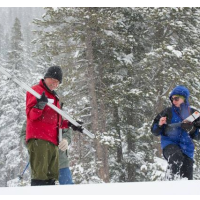Storms Pile up the Sierra Snowpack to a Meager 32% of Normal
 DWR’s Frank Gehrke measures while Nicole Meyer-Morse records (photo: John Chacon, Department of Water Resources)
DWR’s Frank Gehrke measures while Nicole Meyer-Morse records (photo: John Chacon, Department of Water Resources)
April is peak time for measuring snowpack in the Sierra Nevada Mountains, where one-third of California’s water comes from.
After the driest year on record and a short burst of precipitation, dozens of surveyors fanned out across the mountains, stuck their poles in the snow and brought a small measure of relief to trailing media and interested onlookers who strived to regard their glass as half-filled.
That “small” measure of relief was purchased with a dismal reading that found just 32% of normal snowpack. It could have been worse. January measurements were at 20%. An April reading hasn’t been this low since 1988, when snows were at 29%.
This is how Stephen Colbert described to President George W. Bush and company, at the 2006 White House Correspondents Dinner, what it means to have less than half of your glass filled:
“Sir, pay no attention to the people who say the glass is half empty, because 32% means it's 2/3 empty. There's still some liquid in that glass is my point, but I wouldn't drink it. The last third is usually backwash.”
Frank Gehrke, chief of snow surveys for California’s Department of Water Resources (DWR), explained to the San Jose Mercury News why the state is stuck with backwash: “We've had a couple of good storms that put down 2 or 3 feet of snow. But instead of getting six or eight of those this winter, we've only had two or three. And that's the big difference.”
Still, that was enough for Tom Gohring, executive director of the Sacramento Water Forum, a coalition of water agencies and environmental groups, to heave a sigh of relief. He told the Sacramento Bee, “We have gone from a really catastrophic water situation to just a very bad one,” he said.
Maurice Roos, the state’s chief hydrologist, concurred. “It pulled us out of the cellar. But it’s still not going to be enough for everybody.”
Everybody includes Republicans in Congress, who have been pushing to relax environmental regulations, build more dams and pump more water out of the Sacramento-San Joaquin River Delta
The Republican-controlled House of Representatives passed H.R. 3964—the Sacramento-San Joaquin Valley Emergency Water Delivery Act—along party lines in February. Only one Democrat and two Republicans from California switched sides for the vote.
The proposal’s broad outline would increase flows at Delta pumps through 2015 “as long as water is available;” temporarily end environmental restoration flows to the San Joaquin River “to stop wasting water;” and establish a bipartisan House-Senate committee to devise long-term solutions.
The bill faces an uphill climb in the Democratically-controlled Senate and the White House has threatened a veto (pdf) “because it would not alleviate the effects of California's current drought and would disrupt decades of work that supports building consensus, solutions, and settlements that equitably address some of California's most complex water challenges.”
–Ken Broder
To Learn More:
Drought's Not Over Yet: California Storms Improve Sierra Snowpack, But It Still Remains Low (by Paul Rogers, San Jose Mercury News)
Despite Recent Storms, Sierra Snowpack Remains Well Below Normal (by Phillip Reese, Sacramento Bee)
California Snowpack Measure Could Reveal Future of Drought (by Lisa M. Krieger, National Geographic)
Miserable Sierra Snowpack Ties a Record Low Set Way Back in 2012 (by Ken Broder, AllGov California)
- Top Stories
- Controversies
- Where is the Money Going?
- California and the Nation
- Appointments and Resignations
- Unusual News
- Latest News
- California Forbids U.S. Immigration Agents from Pretending to be Police
- California Lawmakers Urged to Strip “Self-Dealing” Tax Board of Its Duties
- Big Oil’s Grip on California
- Santa Cruz Police See Homeland Security Betrayal in Use of Gang Roundup as Cover for Immigration Raid
- Oil Companies Face Deadline to Stop Polluting California Groundwater





